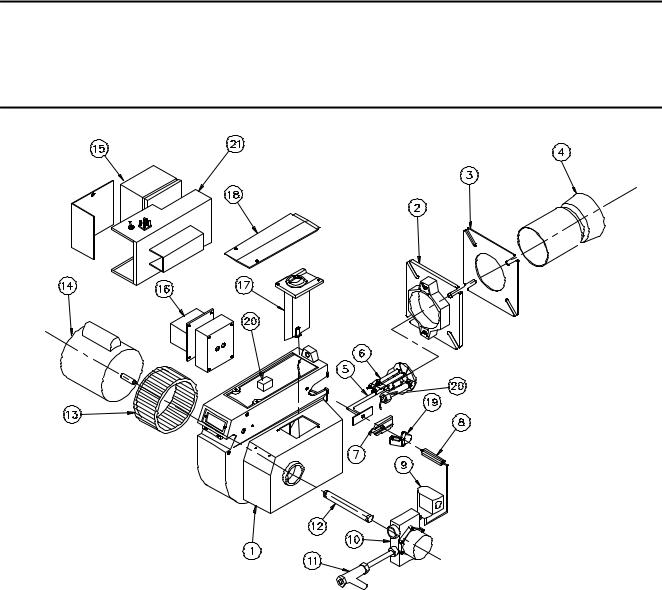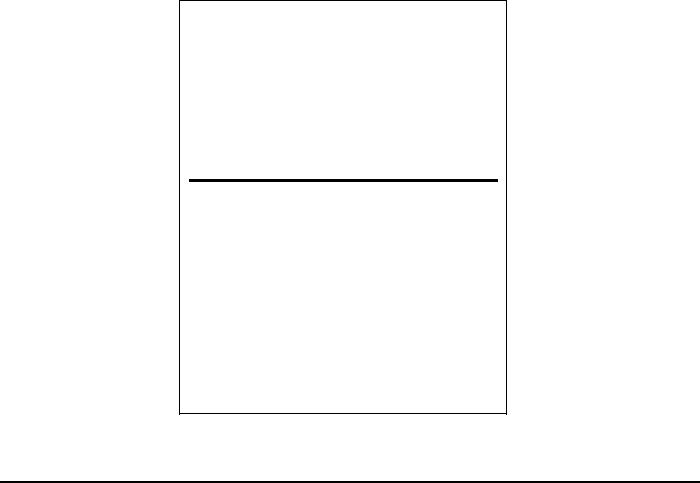PVI Industries FIREPOWER B40 User Manual

INSTALLATION & MAINTENANCE MANUAL FOR
PVI FIREPOWER®
B40 OIL BURNER
1.0 thru 10.0 gph
CARBON MONOXIDE WARNING:
CAUTION: IMPROPER COMBUSTION MAY CAUSE SERIOUS INJURY. PVI recommends a seasonal or annual combustion check-out be performed by a
qualified service agency to ensure safe and efficient operation.
Typical Construction
Figure 22A-1
1. |
Burner housing |
12. |
Pump coupling |
2. |
Mounting flange |
13. |
Fan wheel |
3. |
Flange gasket |
14. |
Fan motor |
4. |
Blast tube |
15. |
Flame safeguard |
5. |
Oil nozzle assembly |
16. |
Ignition transformer |
6. |
Ignition electrodes |
17. |
Damper assembly |
7. |
Housing plug |
18. |
Housing cover |
8. |
Connecting pipe |
19. |
Locating block |
9. |
Electric oil valve |
20. |
Scanner or photocell |
10. |
Oil pump |
21. |
Control enclosure |
11.Oil strainer
PV500-22A 08-98 |
1 |
Section 22A |

PVI FIREPOWER®
B40 OIL BURNER
FOR YOUR SAFETY
DO NOT store or use gasoline or other flammable vapors and liquids in the vicinity of this or any other appliance.
FOR YOUR SAFETY
WARNING: Improper installation, adjustment, alteration, service or maintenance can cause injury or property damage. Refer to this manual for assistance, or consult a qualified service agency.
ELECTRICAL
1.Wiring to the unit should conform to the National Electrical Code or the code legally authorized to your locality. A fused disconnect switch should be used for water heater control. Service wiring connections of 115V, 1 phase, 60 Hz. are located in the enclosure on the water heater. (See Figure 22-10, pg. 14.)
NOTE: Use only copper wire of proper sizing for incoming service. Damage resulting from use of aluminum wiring will be excluded from coverage under the warranty of this unit.
PV500-22A 08-98 |
2 |
Section 22A |
PVI FIREPOWER®
B40 OIL BURNER START-UP
(Refer to Figure 22-1 to identify burner parts)
1.Remove the enclosure panel cover on the water heater or boiler to expose the control circuit. The wiring diagram, located on the backside of the cover, will show the controls used in our circuitry.
2.Visually check that all components are intact and no damage has occurred during transit.
3.Check all connections in control cabinet. A loose connection could cause intermittent shutdowns.
4.Check oil supply lines to insure proper practices have been followed and installation complies with local codes. Use only a two-pipe system. Check for adequate burner intake air supply.
NOTE: Do not tamper with or readjust program dipswitch settings. This will cause the control to become inoperable. Damage resulting from tampering will be excluded from coverage under the warranty of this unit.
5.Remove the flame safeguard control from its base. Check the connections in control mounting base; loose connections can cause nuisance shutdowns. When applicable, check the time card or programmer, for good connection.
6.With electrodes exposed, check them for the proper settings as in Figure 22-4 & 7, pages 7 & 8. Check for any hairline cracks in the insulators. Should replacement of burner electrodes be required, certain procedures must be followed. In all cases, removal of electrodes is accomplished by loosening the electrode mounting clamps. Draw electrodes out of the nozzle assembly through the holes in the pressure plate.
7.Open manual oil valve(s). Make certain check valves are positioned for the correct oil flow. There should not be a manual shut-off valve in the return line from the pump to the tank.
8.Pull the nozzle assembly to check the ignition electrodes. See Figure 22-3 & 6, pages 7 & 8.
9.Inspect the electrodes for cracked ceramic or loose retaining studs that hold the wire within the ceramic. Select the proper pressure plate hole to place each electrode and insert the electrode through the hole, retaining stud end first.
10.Tighten the electrode mounting clamp slightly until electrode ceramics are seated firmly and completely in the mounting bracket without gaps between ceramics and mounting bracket at the bearing faces.
11.Measure and set electrodes according to Figure 22-4 & 7, pages 7 & 8. After gaps and setting are complete, fully tighten electrode mounting clamp.
Do not overtighten or insulation may crack.
12.Replace nozzle assembly; be sure to connect the spark rod wires before installing nozzle assembly fully into blast tube. Check connections on the ends of the flame and spark rod wires for good contact. Look for properly stripped wire ends. Be sure connectors are firmly attached to the ignition rod ends. Insulating boots can give a false feeling of proper seating. DO NOT MOVE ELECTRODES. Be careful not to bump electrodes. Check fan wheel for free rotation.
13.Connect a test meter to the control for reading the flame response signal.
NOTE: Some controls read the flame signal in micro amps and some in volts DC. The MC120 series control has two terminals marked for reading volts DC.
14.Be sure tank is filled with water. Once the burner is reassembled, a gauge to read pressure, preferably a 300 psi gauge, will be needed to read oil pressures. Connect gauge to the pressure side of the oil pump. Connect vacuum gauge to supply side of oil pump (15”HG maximum allowed).
15.Single stage oil burners. Before turning the unit on, make sure all valves in the oil supply and return lines are on. Check the air damper setting against the setup tag attached to the burner. Turn the unit on using the rocker switch on the side of the control cabinet. If the operating control switches are closed, the burner blower should come on and prepurge begins.
If nothing happens, check the control to be sure it is not in the tripped position and reset it by pushing the flame safeguard reset button. Burner should prepurge for no more than thirty seconds.
PV500-22A 08-98 |
3 |
Section 22A |
PVI FIREPOWER®
B40 OIL BURNER START-UP (con't)
After purging is complete, terminal 3 energizes the oil valve and terminal 4 energizes the ignition transformer. The flame is then established and the VDC reading on the meter should read a steady 14-18 VDC for photocell or 4-6 VDC for UV amplifiers. Each different control will have the required flame response signal stamped on it. This is the minimum for it to properly operate. If the burner fails to light during the initial period, it is probably due to air in the line. The control will lock out. Push the flame safeguard reset button to restart burner and begin the purge cycle again.
Once the flame is established, set the oil pressure (measured at the oil pump) at the pressure shown on the tag attached to the burner. Oil pressure should be adjusted while firing on the second stage. Do not exceed the oil supply pressure specified on the setup tag.
16.Two stage oil burners. Before turning the unit on, make sure all valves in the oil supply and return lines are on. Check the first stage air damper setting against the setup tag attached to the burner. The second stage air setting must be adjusted while the burner is operating. Turn the unit on using the rocker switch on the side of the control cabinet. If the operating control switches are closed, the burner blower should come on and prepurge begin.
If nothing happens, check the control to be sure it is not in the tripped position and reset it by pushing the flame safeguard reset button. The burner should prepurge for no longer than thirty seconds.
After purging is complete, terminal 3 energizes the oil valve and terminal 4 energizes the ignition transformer. The flame is then established and terminal 5 energizes the main oil valve after a short delay. This will simultaneously supply oil to the second stage oil nozzle and the damper actuator, driving the damper open. The burner can be temporarily locked in the first or second stage by adjusting the low-fire hold switch. The VDC reading on the meter should read a steady 14-18 VDC for photocell or 4-6 VDC for UV amplifiers. Each different control will have the required (minimum) flame response signal stamped on it. If the burner fails to light during the initial period, check for air in the line. The control will lock out. Push flame safeguard reset button to restart burner and begin purge cycle again.
Once the flame is established, set the oil pressure (measured at the oil pump) at pressure shown on the tag attached to the burner. Oil pressure should be adjusted while firing on the second stage. Do not exceed the oil supply pressure specified on the setup tag.
17.Check flue gases with a flue analyzer and smoke spot pump to make final settings of the air damper.
a.Readings need to be taken from a hole in the vent several inches from flue outlet connection.
b.Insert draft gauge into the test opening in the stack. Draft in stack should read -.02" to -.06" W.C. Adjust draft regulator, if installed.
c.Insert analyzer in test opening and determine O2 content in percentage.
d.Gradually close air damper to decrease O2 reading or open air damper to increase O2 reading until optimum O2 % (4-5%) is reached. Refer to Figure 22-2 & 5, pages 7 & 8 for damper adjustment details.
e.Once the O2 reading is in the specified range, check smoke content in the flue gas by pumping ten times through a new smoke spot sample paper. Smoke spot should not exceed a #2. If the smoke spot exceeds a #2, it may be necessary to increase the O2 %.
f.Once combustion is set, take note of the gross stack temperature; maximum gross stack is to be 400°F, minimum net stack is to be 300°F.
(NOTE: net temperature is the total stack temperature, less room temperature.) If an excessively high gross stack temperature is recorded, consult the factory.
g.Make sure air shutter is locked securely in place.
18.On two-stage oil burners, the preceding analysis must be done for the first and second stage.
19.Check each operating and limit control to be sure they function properly by lowering and raising the temperature setting on each of the controls, causing the burner to cycle on and off.
PV500-22A 08-98 |
4 |
Section 22A |
